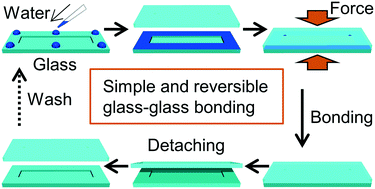A simple and reversible glass–glass bonding method to construct a microfluidic device and its application for cell recovery†
Abstract
Compared with polymer microfluidic devices, glass microfluidic devices have advantages for diverse lab-on-a-chip applications due to their rigidity, optical transparency, thermal stability, and chemical/biological inertness. However, the bonding process to construct glass microfluidic devices usually involves treatment(s) like high temperature over 400 °C, oxygen plasma or piranha solution. Such processes require special skill, apparatus or harsh chemicals, and destroy molecules or cells in microchannels. Here, we present a simple method for glass–glass bonding to easily form microchannels. This method consists of two steps: placing water droplets on a glass substrate cleaned by neutral detergent, followed by fixing a cover glass plate on the glass substrate by binding clips for a few hours at room temperature. Surface analyses showed that the glass surface cleaned by neutral detergent had a higher ratio of SiOH over SiO than glass surfaces prepared by other cleaning steps. Thus, the suggested method could achieve stronger glass–glass bonding via dehydration condensation due to the higher density of SiOH. The pressure endurance reached over 600 kPa within 6 h of bonding, which is sufficient for practical microfluidic applications. Moreover, by exploiting the reversibility of this bonding method, cell recoveries after cultivating cells in a microchannel were demonstrated. This new bonding method can significantly improve both the productivity and the usability of glass microfluidic devices and extend the possibility of glass microfluidic applications in future.



 Please wait while we load your content...
Please wait while we load your content...